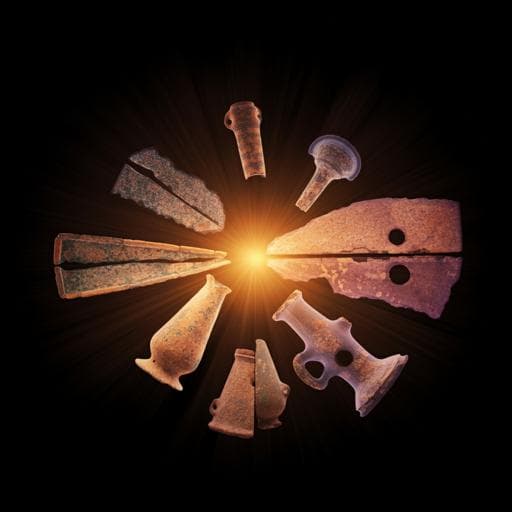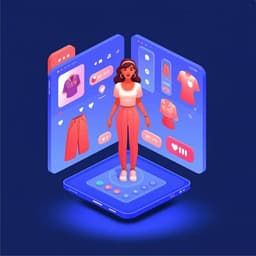
The Arts
Enabling 3D CT-scanning of cultural heritage objects using only in-house 2D X-ray equipment in museums
F. G. Bossema, W. J. Palenstijn, et al.
This groundbreaking research by Francien G. Bossema and colleagues showcases a new method for generating CT scans of museum artifacts using standard 2D radiography equipment, significantly pushing the boundaries of museum technology. Discover how leading institutions like the British Museum and the J. Paul Getty Museum are benefiting from this innovative approach!
~3 min • Beginner • English
Introduction
CT imaging provides non-invasive access to the internal structures of cultural heritage objects, revealing information on manufacture, condition, materials, and sometimes authorship. While CT originates in healthcare, it is widely used in industry and cultural heritage, with applications from understanding manufacturing processes and condition to advanced processing such as virtual unfolding and multimodal integration. Museums commonly rely on 2D radiography due to flexibility and accessibility, but single projections lose depth information, limiting interpretability. Dedicated CT systems require precise, calibrated gantries or rotation stages and suffer from constraints on object size, shape, and transport logistics for fragile, unique artifacts. Although clinical CT, micro-CT, portable CT setups, and even synchrotron imaging have been employed, these options are often costly, size-restricted, or logistically challenging. This work addresses the gap by enabling accurate 3D CT reconstructions using standard in-house 2D radiography equipment via a marker-based acquisition protocol and computational parameter derivation, thereby eliminating the need for expensive CT hardware and enabling on-site 3D imaging in museum suites.
Literature Review
Prior work in cultural heritage CT spans clinical CT of large objects (e.g., paintings and mummies), micro-CT for higher resolution tasks (e.g., dendrochronology, panel painting analysis, unopened letters), and rare synchrotron studies for very small, high-resolution targets. These systems impose limitations on object size, accessibility, and cost. Portable CT solutions have been demonstrated to address in situ needs, and some museums have built custom setups or acquired in-house CT systems, though at significant expense. Calibration and motion correction methods using markers or phantoms are established in medical and industrial CT, typically relying on pre-fabricated phantoms with known marker positions and assuming equidistant projection angles. Alternative methods include adaptable phantoms (e.g., LEGO) or arbitrary marker placements, generally requiring pre-scans and reliable rotation hardware. Optimization-based techniques adjust system parameters or jointly refine reconstruction and alignment but often assume approximate initial parameters and are sensitive to object features. The present work differs by estimating all geometric parameters, including non-equidistant angles, from markers embedded in situ with the object, removing dependence on pre-calibrated systems, pre-scans, or reliable rotation hardware and enabling flexible application across uncalibrated radiography suites.
Methodology
The approach enables CT reconstruction using standard 2D radiography systems augmented with small metal markers placed in foam around the object. Workflow: (1) Acquire radiographs over a full circular trajectory using the in-house radiography suite with the object and marker holder on a rotation stage. (2) Detect and label marker projections across radiographs. (3) Derive all geometric system parameters post-scan using the marker trajectories. (4) Preprocess radiographs (flat- and dark-field correction) and remove markers via inpainting. (5) Reconstruct the 3D volume using iterative algebraic methods.
Core model: The forward operator encapsulates system geometry; the unknown parameter set includes source location, detector location and orientation (tilts and in-plane rotation), detector pixel size, projection angles (which may be non-equidistant), and unknown 3D marker positions within the foam. Marker positions are not pre-measured; projected marker locations are detected in each radiograph. Parameter estimation minimizes the sum of squared differences between measured and predicted projected marker locations across all radiographs and markers using least squares. With the estimated geometry, the volumetric reconstruction solves a least-squares formulation using SIRT (an iterative gradient-descent style algorithm) to minimize residuals between forward projections of the current volume estimate and the measured data.
System independence: The method is agnostic to rotation control fidelity, allowing for start-stop or continuous rotation and variable angular increments. When systems provide equidistant angles and stable geometry, a pre-calibration without including markers in object scans is possible; otherwise, markers remain during acquisition and are removed by inpainting prior to reconstruction.
Implementations: The pipeline was deployed at three museum radiography suites (British Museum; J. Paul Getty Museum; Rijksmuseum) and a micro-CT reference facility (FleX-ray lab). For the cross-facility comparison, a small wooden block (yew) was scanned at all sites using facility-appropriate settings. For the case study, the Barye plaster model at the Getty was scanned with 17 markers placed to avoid dense regions, 718 radiographs over two revolutions, 450 kV, 2 mA, exposure 2.85 s per capture with averaging of four captures to reduce noise.
Key Findings
- Cross-facility wooden block study: Using post-scan marker-based parameter retrieval on non-CT museum radiography systems produced 3D reconstructions revealing the same internal structures (tree rings, saw cut) as the British Museum’s calibrated CT workflow and the FleX-ray micro-CT reference, albeit at lower effective resolution for the museum radiography setups. Line profiles demonstrate sufficient contrast to distinguish tree rings. Image quality was highest at the British Museum setup designed for CT; the Getty and Rijksmuseum reconstructions exhibited lower resolution influenced by larger focal spot sizes and geometric constraints.
- Representative scan parameters for the wooden block: British Museum (60 kV, 3 mA, 0.4 mm focal spot, 1800 projections, 1 round, 1.0 s exposure, ~99 min total); Getty Museum (60 kV, 15 mA, 2.5 mm focal spot, 1469 projections, 3.05 rounds, 0.9 s exposure, ~295 min total); Rijksmuseum (65 kV, 4.5 mA, 0.5 mm focal spot, 1350 projections, 2 rounds, 0.1 s exposure, ~3.5 min total); FleX-ray micro-CT (60 kV, 800 µA, 0.017 mm focal spot, 1440 projections, 1 round, 0.4 s exposure, ~13 min total).
- Case study (Barye’s Python Killing a Gnu): CT slices provided definitive evidence that the original rectangular base is embedded within later plaster additions; identified three distinct plaster layers (an initial fine thin shell capturing surface detail, a secondary thicker support layer, and a third high-porosity plaster fill added to embed a metal armature during reconfiguration); revealed extensive wax fills where plaster replacement was impractical (notably in the gnu’s neck) and surface modeling wax used to adjust musculature; enabled precise localization of armature endpoints and material density variations. These insights were not achievable from 2D radiographs alone and confirmed key hypotheses about the object’s reconfiguration history.
- Accessibility milestone: To the authors’ knowledge, this work enabled the first 3D X-ray CT reconstructions using the basic in-house radiography setups at the Getty Museum and the Rijksmuseum without additional hardware investment.
Discussion
The work addresses the fundamental barrier preventing widespread CT use in museums: reliance on expensive, dedicated, pre-calibrated CT hardware and the logistical challenges of transporting fragile objects. By estimating all geometric parameters post-scan from on-object markers, the approach decouples CT reconstruction from precise motion control and pre-calibrated systems, enabling flexible 3D imaging with existing radiography suites. The method’s ability to recover non-equidistant angles and complete geometry from marker trajectories is a key innovation relative to prior calibration approaches that depend on dedicated phantoms and reliable rotation hardware.
Results demonstrate practical feasibility across multiple facilities and object types: internal wood features are recovered at adequate contrast for expert inspection, and a complex plaster sculpture’s construction and alteration history is resolved, validating hypotheses that were ambiguous from radiographs. While effective resolution varies with hardware (e.g., focal spot size, source-object-detector distances), the 3D volumes afford depth-resolved visualization, unlocking interpretive power beyond 2D projections. The approach also provides a means to verify system assumptions (e.g., angular spacing) and potentially pre-calibrate stable parameters when appropriate.
The method aligns with broader cultural heritage needs by minimizing cost, reducing transport risks, and integrating computational techniques into conservation workflows. It complements and extends prior calibration and optimization literature by treating all geometry and marker positions as unknowns and solving the full estimation problem tailored to uncalibrated, flexible setups.
Conclusion
This study introduces a practical, low-cost method to perform 3D CT reconstructions using standard museum radiography equipment, eliminating the dependency on dedicated CT scanners. By combining a simple marker protocol with post-scan parameter derivation and iterative reconstruction, the method produced accurate 3D volumes at three museum facilities and a micro-CT lab, enabling internal structural analysis not accessible via radiography alone. The case study on the Barye plaster model highlights the method’s impact in confirming complex construction histories and material distributions.
Future directions include: (1) enabling horizontal and vertical tiling to image larger objects across multiple source-detector positions; (2) further automation and a user-friendly interface to reduce reliance on computational specialists; (3) application to portable and robotic X-ray systems using generalized trajectories; and (4) development of workflows to incorporate absolute scaling during or post reconstruction for quantitative analyses.
Limitations
- Resolution constraints: Final image resolution is limited by available hardware, particularly X-ray tube focal spot size and achievable source-object-detector distances, which vary by setup.
- Absolute scale: The reconstruction does not inherently recover physical scale. Measurements require inclusion of a known-size object, known marker spacing, or a measured feature for scaling.
- Field of view: Detector size limits the maximum object dimensions that can be scanned in a single acquisition.
- Motion and tiling: Hardware motion flexibility constrains feasibility of tiled scans; systems where source and detector move together complicate stitching and may require simultaneous multi-tile reconstruction.
Related Publications
Explore these studies to deepen your understanding of the subject.







